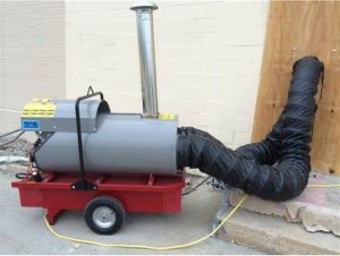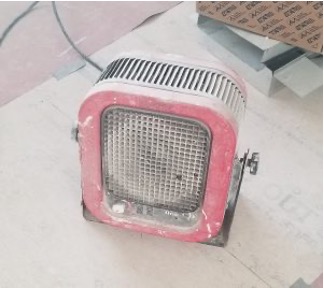If you live in a northern climate and have made a career out of construction, or even if you are a do-it-yourselfer, when the cold months roll around, you may need to temporarily heat a space you are working in. In this post, I will discuss several different heating fuels, the amount of heat they can provide along with current costs, and how the choice of a temporary heating system can affect a building.
An overview of options
For years, I used fuel oil for a temporary heat source on many wintertime builds. Torpedo heaters, which are primarily fueled by kerosene or diesel, put out a lot of heat in a short amount of time. The one I used the most was a 100,000 BTU thermostatically controlled unit that held 5 gal. of fuel. There were significant drawbacks to this method. First there was the amount of noise it created; it sounds like a jet engine taking off. It also stinks; the exhaust of the burned fuel is vented directly into the structure, impacting air quality in the building.
On top of that, was the cost of operating it. At 100,000 BTU, my heater would go through nearly a gallon an hour costing $4 per hour at current prices. Additionally, the fuel tank needs to be filled outside; were there a fuel spill inside, the smell of diesel fuel could potentially soak into the building materials. The only good thing about this heater was the amount of heat it put out but it came at cost.
(Note that the terms “torpedo” and “salamander” in the context of portable job site heaters are used interchangeably but there are some differences, the primary one being type of fuel used. Torpedo heaters are fueled by kerosene or diesel, while salamander heaters generally use propane. They also have slightly different designs.)
I’ve also used unvented propane heaters as a temp heat source. I had both a torpedo heater and a radiant open flame space heater. Though they were cheaper to operate, around $2.50 per 100,000 BTUs, they had similar problems to the fuel oil heat. Odors, noise, and the risk of carbon monoxide poisoning. On top of that, there is the moisture issue; with propane, every 100,000 BTU produced, approximately 1 gal. of moisture is released into the home. (Natural gas produces even more at 1.25 gal.) Keeping a home as dry as possible during the construction process is important. Dehumidification will almost always be required while finishing the interior due to the concentration of moisture in new building materials.

An indirect heating system is another option. In this case, the fossil-fueled equipment is kept outside the building envelope and a duct moves the heat inside. Combustion takes place outside, so there are no indoor combustion gasses, odors, or associated moisture; there is also less noise inside.
For the concrete-free slab-on-grade home that I was involved with a few years ago, we used two different electric space heaters. The first was a larger unit with two settings, 5000 watts and 3300 watts. We operated it on the 3300-watt setting at night only. During the day, a smaller 1500-watt heater was used. Electric heaters are much quieter than the forced-air torpedo heaters, and they don’t impact IAQ. Their biggest advantage is zero moisture load added to the structure. The disadvantage is the cost. Electricity rates in the area are around $0.14 per kW. At 3300 watts, or 3.3 kW, the cost per hour is a little over $0.45.

Although electric heaters are cheaper to operate, they also have a lower heat output; 3.3 kW produces around 11,250 BTU. We would need nine times that amount to equal the heat output for the larger gas heaters, increasing the cost to $4 per hour, which is roughly the same as the fuel oil heater. Luckily, the amount of heat the electric heaters produced was more than enough due to the robust building envelope—another advantage to building tight, well-insulated homes.
How much heat are we talking?
At roughly 130,000 BTU, fuel oil produces the most BTU per gal. Natural gas is next at 100,000 per therm. Propane has around 92,000 BTU per gal., and electricity produces 3412 BTU per kW. (This older post talks about heat output and the costs of different heating fuels; even though the fuel costs are outdated, the information is still useful.)
Why not just use the permanent heat source to heat the home during construction? We can if it is a radiant heat source (no moving air) but forced-air systems include ductwork and we don’t want construction dust and debris to accumulate inside the ducting.
Temporary heat is often necessary for keeping construction moving during cold weather but know that moisture, carbon monoxide, and air quality are all potential issues. (Soot can also be a concern, especially if interior finishing is in process.) In short, the type of heat supply can affect not only workers, but also the structure and its operating systems, so choose wisely.
____________________________________________________________________
Randy Williams is a builder and energy rater based in Grand Rapids, Minnesota. Photos courtesy of the author.
Weekly Newsletter
Get building science and energy efficiency advice, plus special offers, in your inbox.
